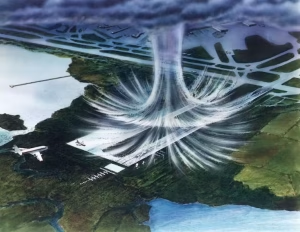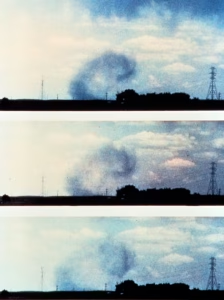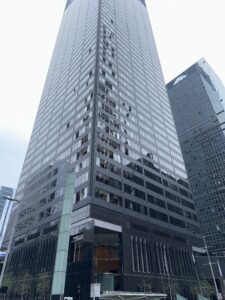By Amal Elawady, Fahim Ahmed, Mohamed Eissa and Omar Metwally, Florida International University
From a distance, a downburst can look like a torrent of heavy rain. But at ground level, its behavior can be far more destructive.

When a downburst’s winds hit the ground, they shoot out horizontally in all directions, sometimes with enough force to shatter windows and overturn vehicles.
These winds behave in complicated ways, particularly in cities, as our latest research shows. Downburst winds can deflect off tall buildings, increasing the pressure on neighboring buildings’ windows and walls. The result can blow out glass and chip off facade. Even buildings designed to survive hurricanes can suffer major damage in a downburst.
As engineers, we study downbursts with the goal of designing buildings, components such as solar panels and windows, and infrastructure such as power lines that can stand up to that powerful force. To do this, informed by field measurements, we create our own powerful downbursts using a hurricane simulator known as the Wall of Wind at Florida International University.
What is a downburst?
Downbursts can be as destructive as tornadoes, but their winds develop in a very different way.

A downburst forms when a thunderstorm pulls cooler, heavier air down from high in the atmosphere. As this rain-cooled air rushes downward, it gains speed. Once it slams into the ground, it has nowhere to go but outward, sending strong winds in all horizontal directions.
The wind speed in a downburst can reach over 150 miles per hour. That’s the strength of a Category 4 hurricane and strong enough to knock down trees and power lines, damage buildings and flip vehicles.
These winds also rotate, but not in the same way tornadoes do. Downburst winds are typically considered straight-line winds, but they rotate around a horizontal axis as the wind curls upward after hitting the ground. Tornadoes, in contrast, spin around a vertical axis.
Powerful storm systems known as derechos are often made up of multiple downburst clusters, each containing many smaller downbursts, sometimes called microbursts.
Recreating Houston’s downburst in a warehouse
On May 16, 2024, a derecho hit Houston with a downburst that was so strong, it blew out windows in several high-rise buildings that had been built to survive Category 4 hurricanes. The winds also pried off chunks of buildings’ facades.

Two months later, Hurricane Beryl hit Houston with similar wind speeds, yet it left minimal damage to the downtown buildings.
To understand how a downburst like this can be so much more destructive – and what cities and building designers can do about it – we simulated both the Houston downburst winds and Hurricane Beryl’s winds in the Wall of Wind.
The test facility is equipped with a dozen jet fans, each almost as tall as the workers who run them and powerful enough to simulate a Category 5 hurricane. Our team used these fans to recreate powerful downburst winds that hit horizontally with the maximum wind speeds near ground level. Then, we put several models of buildings to the test to see how roofs, windows, facades and the structures of power lines reacted under that force.
In the Houston derecho, a downburst hit downtown with 100 mph winds. It cracked some lower windows, likely with blowing debris, but it also caused widespread unexpected damage midway up some of the buildings.
The Chevron Building Auditorium actually suffered the most damage on a side that wasn’t directly in the line of the storm but was facing another tall building. That left some intriguing questions. It suggested that the way the buildings channel the wind may have created a strong suction that blew out windows midway up the tower. Another burning question is whether building design codes are outdated when it comes to how well their cladding can stand up to these localized winds.
Using the Wall of Wind, we were able to test those pressures on models of the Houston buildings and see how downburst winds increased the pressured on a tall building model with excessive forces near the ground level.
The ability to simulate these winds is important for improving engineers’ understanding of the differences in how downbursts and other wind events exert force on buildings. The results ultimately inform building standards to help create more resilient and better-protected communities.
Building better power lines
Big storms, like downbursts, can also take down power lines.
Power lines extend hundreds of miles between cities and states, making them more susceptible to a hit from a localized severe storm, such as a downburst. If one of the towers falls, it can cause a chain reaction, like dominoes falling one after another. That can knock out power for large numbers of people.
With colleagues, we have been testing transmission towers and multispan power-line systems under downburst and hurricane winds to understand how these structures respond, with the goal of developing better construction techniques. That work has helped to update the American manual for the design of power lines, which engineers use for designing safer, more storm-resilient transmission towers.
What’s next
Low-rise and mid-rise buildings are also vulnerable to downbursts, but the effects are less well understood. Downburst winds are most intense between 10 and 300 feet above the ground, meaning the roofs and walls of some low-rises can be hit with intense horizontal wind.
Recent building codes have offered design guidelines to help ensure these buildings can withstand tornadoes. However, the way downbursts rotate in a short time around a building or a community of buildings puts pressure on the walls and the roof in different ways. Similar to straight-line winds, we expect high suction on the roof. Due to their short duration, varying wind direction and intense wind speed, downbursts may also cause excessive vibrations and varying pressure distribution on the roof components.
We’re now testing downburst damage to low- and mid-rise buildings to better understand the risks and help highlight changes that can make buildings more resilient.
As populations grow, cities are adding more buildings. At the same time, powerful storms are becoming more frequent and more intense. Understanding the effects of different types of storms will help engineers construct high-rises, low-rises and power lines that are better able to withstand extreme weather.![]()
Amal Elawady is an associate professor of civil and environmental engineering, and Fahim Ahmed, Mohamed Eissa and Omar Metwally are graduate research assistants at the Extreme Events Institute, all at Florida International University.
This article is republished from The Conversation under a Creative Commons license. Read the original article. Banner photo: A billboard bent over due to a derecho in Johnsville, New York, in 2020 (NWS Storm Survey, Public domain, via Wikimedia Commons).
Sign up for The Invading Sea newsletter by visiting here. To support The Invading Sea, click here to make a donation. If you are interested in submitting an opinion piece to The Invading Sea, email Editor Nathan Crabbe at nc*****@*au.edu.



